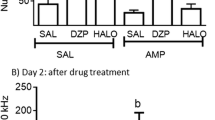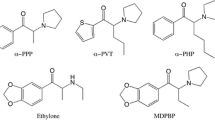Abstract
In the present experiments, the effects of a wide range of doses of d-amphetamine and apomorphine were studied on investigatory behavior in an automated eight-hole box. Amphetamine (0.125, 0.25, 0.5, 1.0, 3.0, 5.0 mg/kg) increased frequency and total duration of responses, and decreased mean duration in a dose-dependent manner. The strategy and organization of responses, as measured by the order of hole-visits and hole-switching, were unchanged at lower doses of amphetamine but were altered at higher doses. Perseverative hole-poking was observed at the highest dose (5.0) as indicated by increased number of hole-pokes per hole-visit. Apomorphine (0.05, 0.1, 0.2, 0.4, 0.8, 1.6, 3.2 mg/kg) decreased mean duration of responses, but in contrast to amphetamine markedly diminished frequency. Locomotor activity was also measured at all doses of both drugs. Our observations indicate that these two stimulant drugs both of which increase motor activity, have markedly different effects on investigatory responses. It is likely that amphetamine increases prepotent response tendencies (i.e., hole-poking), although this does not necessarily reflect enhanced exploration. Further, the results obtained with amphetamine support predictions made by the Lyon-Robbins behavioral theory of amphetamine effects.
Similar content being viewed by others
References
Ahlenius S, Engel J, Zoller M (1977) Effects of apomorphine and haloperidol on exploratory behavior and latent learning in mice. Physiol Psychol 5:290–294
Berlyne DE (1960) Conflict, arousal and curiosity. McGraw Hill, New York
Boissier JR, Simon P (1962) La réaction d'exploration chez la souris. Thérapie XVII, 1225–1232
Boissier JR, Simon P, Lwoff JM (1964) L'utilisation d'une réaction particulière de la souris (méthode de la planche à trous) pour l'étude des médicaments psychotropes. Thérapie XIX:571–587
Bruning JL, Kintz BL (1977) Computational handbook of statistics. Scott, Foresman and Company, Glenview, Illinois, pp 112–113
Cador M, Kelley AE, Le Moal M, Stinus L (1985) Behavioral analysis of the effect of neurotensin injected into the ventral mesencephalon on investigatory and spontaneous motor behavior in the rat. Psychopharmacology 85:37846
Carlsson A (1975) Dopaminergic autoreceptors. In: Almgren O, Carlsson A, Engel J (eds) Chemical tools in catecholamine research, vol II, North Holland, Amsterdam, pp 219–225
Cheal ML (1980) Disruption of selective attention by apomorphine but not amphetamine in the mongolian gerbil. Psychopharmacology 69:93–100
Cheal ML (1983) l-Dopa and piribedil alter different components of attentional behavior dependent on dose. Psychopharmacology 80:345–350
Corey DT (1978) The determinants of exploration and neophobia. Neurosci Biobehav Rev 2:235–253
DiChiara G, Porceddu ML, Vargiu L, Argiolas A, Gessa GL (1976) Evidence for dopamine receptors in the mouse brain mediating sedation. Nature 264:564–567
Evenden JL, Robbins IW (1983) Increased response switching, perseveration and perseverative switching following d-amphetamine in the rat. Psychopharmacology 80:67–73
File SE (1977) Effects of parachlorophenylalanine and amphetamine on habituation of exploration. Pharmacol Biochem Behav 6:151–156
File SE (1981) Pharmacological manipulations of responses to novelty and their habituation. In: Copper SJ (ed) Theory in psychopharmacology, vol I, Academic Press, New York, pp 197–232
File SE, Wardill AG (1975) Validity of head-dipping as a measure of exploration in a modified hole-board. Psychopharmacologia 44:53–59
Fray PJ, Sahakian BJ, Robbins TW, Koob GF, Iversen SD (1980) An observational method for quantifying the behavioral effects of dopamine agonists: contrasting effects of d-amphetamine and apomorphine. Psychopharmacology 69:253–259
Gaffori O, Le Moal M, Stinus L (1980) Locomotor hyperactivity and hyperexploration after lesion of the dopaminergic-A10 area in the ventral mesencephalic tegmentum (VMT) of rats. Behav Brain Res 1:313–329
Gianutsos G, Moore KE (1980) Differential behavioral and biochemical effects of four dopaminergic agonists. Psychopharmacology 68:139–146
Hughes RN (1968) Behaviour of male and female rats with free choice of two environments differing in novelty. Anim Behav 16:92–96
Hughes RN, Greig AM (1976) Effects of caffeine, methamphetamine and methylphenidate on reactions to novelty and activity in rats. Neuropharmacology 15:673–676
Isaacson RL, Yongue B, McClearn D (1978) Dopamine agonists: their effect on locomotion and exploration. Behav Biol 23:163–179
Kelley AE, Cador M, Stinus L (1985) Behavioral analysis of the effect of substance P injected into the ventral mesencephalon on investigatory and spontaneous motor behavior in the rats. Psychopharmacology 85:37–46
Kumar R (1969) Exploration and latent learning: differential effects of dexamphetamine on components of exploratory behavior in rats. Psychopharmacologia 16:54–72
Kumar R (1971) Extinction of fear I: Effects of amylobarbitone and dexamphetamine given separately and in combination on fear and exploratory behavior in rats. Psychopharmacologia 19:163–187
Ljungberg T, Ungerstedt U (1976) Automatic registration of behaviour related to dopamine and noradrenaline transmission. Eur J Pharmacol 36:181–188
Ljungberg T, Ungerstedt U (1978) A method for simultaneous recording of eight behavioral parameters related to monoamine neurotransmission. Pharmacol Biochem Behav 8:483–490
Lyon M, Robbins T (1975) The action of central nervous system stimulant drugs: a general theory concerning amphetamine effects. In: Essman W, Valzelli L (eds) Current developments in psychopharmacology, vol 2, Spectrum, New York, pp 79–163
Makanjuola ROA, Hill G, Dow RC, Campbell G, Ashcroft GW (1977) The effects of psychotropic drugs on exploratory and stereotyped behavior of rats studied on a hole board. Psychopharmacology 55:67–74
Nickolson VJ (1981) Detailed analysis of the effects of apomorphine, and d-amphetamine on spontaneous locomotor behaviour of rats as measured in a TV-based automated open-field system. Eur J Pharmacol 72:45–56
Randrup A. Munkvad I (1966) Role of catecholamines in the amphetamine excitation response. Nature (Lond) 211:540–542
Rebec GV, Bashore TR (1984) Critical issues in assessing the behavioral effects of amphetamine. Neurosci Biobehav Rev 8:153–159
Robbins TW (1977) A critique of the methods available for the measurement of spontaneous motor activity. In: Iversen LL, Iversen SD, Snyder SM (eds) Handbook of psychopharmacology, vol 7, Plenum, New York, pp 37–82
Robbins TW, Everitt BJ (1982) Functional studies of the central catecholamines. Int Rev Neurobiol 23:363–365
Robbins TW, Iversen SD (1973) A dissociation of the effects of d-amphetamine and locomotor activity and exploration in rats. Psychopharmacologia 28:155–164
Robbins TW, Sahakian BJ (1983) Behavioral effects of psychomotor stimulant drugs: clinical and neuropsychological implications. In: Creese I (ed) Stimulants: Neurochemical, behavioral and clinical perspectives, Raven Press, New York
Robbins TW, Watson BA (1981) Effects of d-amphetamine on response repetition and “win-stay” behavior in the rat. In: Bradshaw CM, Szabadi E, Lowe CF (eds) Quantification of steady-state operant behaviour, Elsevier North-Holland Biomedical Press, Oxford
Schiørring E (1971) Amphetamine-induced selective stimulation of certain behavior items with concurrent inhibition of others in an open-field test with rats. Behaviour 39:1–17
Schiørring E (1979) An open-field study of stereotyped locomotor activity in amphetamine-treated rats. Psychopharmacology 66:281–287
Segal DS (1975) Behavioral characterization of d- and l-amphetamine: neurochemical implications. Science 190:475–477
Winnock M, Stinus L, Le Moal M (1982) Dose-response analysis of activity in a hole-box after d-amphetamine administration: behavioural activation and behavioural focalisation. Neurosci Lett Suppl 10:S 521
Author information
Authors and Affiliations
Rights and permissions
About this article
Cite this article
Kelley, A.E., Winnock, M. & Stinus, L. Amphetamine, apomorphine and investigatory behavior in the rat: Analysis of the structure and pattern of responses. Psychopharmacologia 88, 66–74 (1986). https://doi.org/10.1007/BF00310515
Received:
Revised:
Issue Date:
DOI: https://doi.org/10.1007/BF00310515




